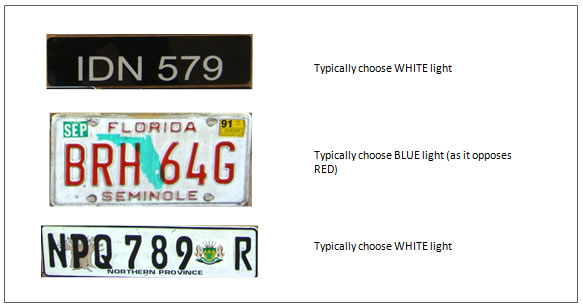Wavelengths for ANPR / LPR illumination applications
A major consideration for automatic number plate recognition systems, which is very much application-driven, is choice of wavelength. Influencers of this include: whether black and white or colour images are required (for example, for some enforcement applications both a black and white image capture of a vehicle's number plate and a colour image of the whole vehicle and its surroundings are needed),and whether a 24-hour capability is needed (the use at night of strobe lighting operating in the visible spectrum can be confusing and dangerous for road users, and may in any case not be able to address the needs of the application at hand,infra-red may therefore be the better choice).

Many users consider the choice between lighting systems operating in the visible and infra-red spectrums to be a straightforward one. This is not necessarily the case, as different portions of the infra-red spectrum itself may also be more suitable for different applications. For example, in the case of automatic number plate recognition applications the wide variety of fonts, colours and sizes used in plate designs can affect choice. The figure above shows a few examples of plates from around the world with the colour light recommended based on the colour contrast chart.
Other applications include the location and reading of windscreen-mounted stickers which are used to identify those who have paid to use tolled facilities and who should therefore be allowed access/not be charged again, and identifying the number of occupants in a vehicle/whether seat-belts are being worn. For each of these, a different portion of the infra-red spectrum might be needed.
Environmental conditions can also have an appreciable effect. Varying light caused by time of day, whether an application is above ground or in a tunnel (where entering or leaving a portal can give rise to still further challenges), the effects of heat and cold, precipitation (mist, fog, rain and snow) and dust all have to be taken into account.
Finally, users have to consider whether the application is going to be fixed or mobile. In the case of the former, expected environmental conditions can often be more accurately predicted or closely controlled. Mobile applications, by contrast can make far greater demands on a system's flexibility.
In many situations visible light solutions are perfectly adequate. In others, they simply cannot provide the necessary performance. Expert advice should be sought from a company such as Gardasoft. Some typical considerations with respect to choice of Visible and IR wavelengths:
- White/visible works well but can distracts drivers
- 740nm is visible but not blinding. Need 740nm if looking through windscreens (face recording, permits). Has the highest camera sensitivity but overall effectiveness is lower than 850nm
- 850nm has highest combination of light output/camera sensitivity, so gives best results for LPR. It can be slightly perceived by humans
- 940nm is almost totally covert. However camera sensitivity is very low and so lots of light is needed
Traffic technology White Paper
LED Traffic Strobe Lights - for high intensity ANPR and LPR applications

